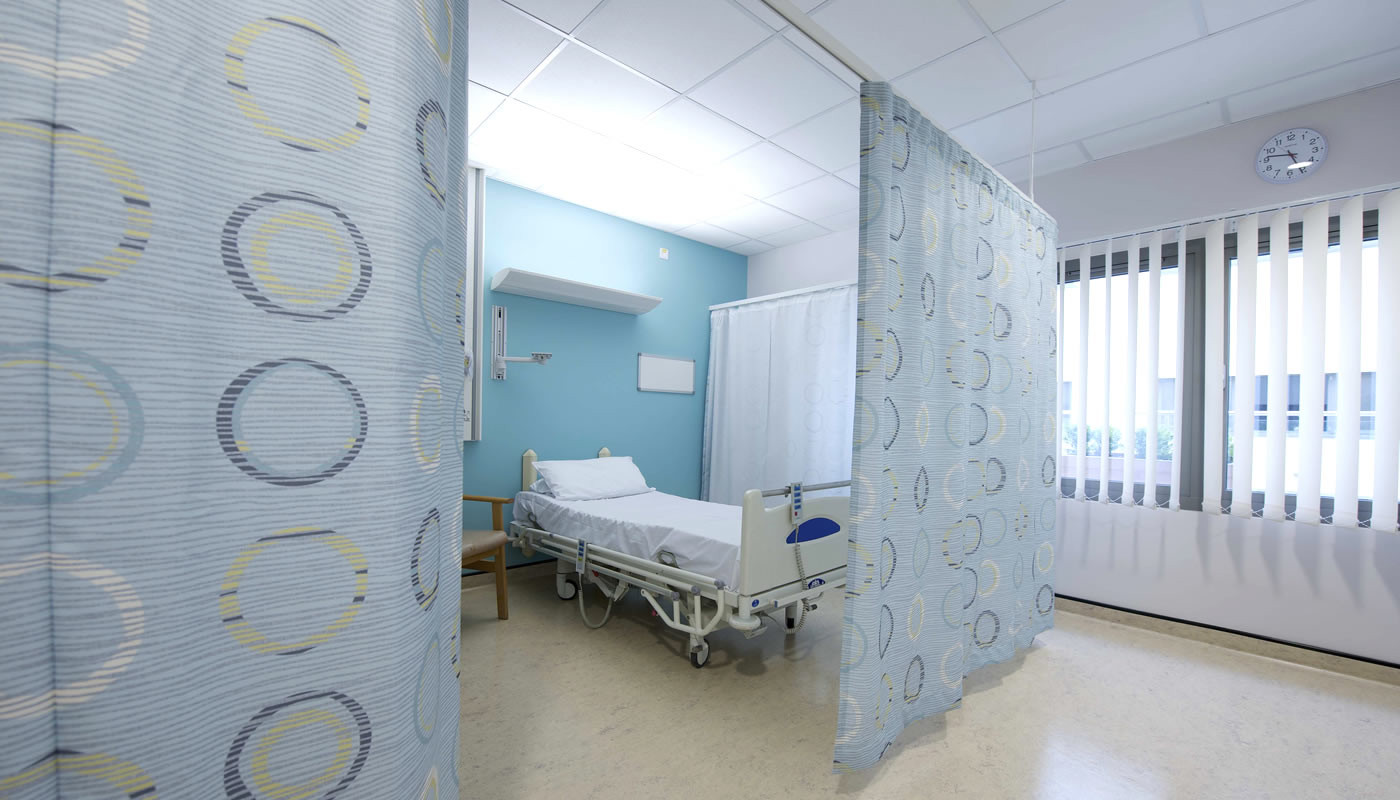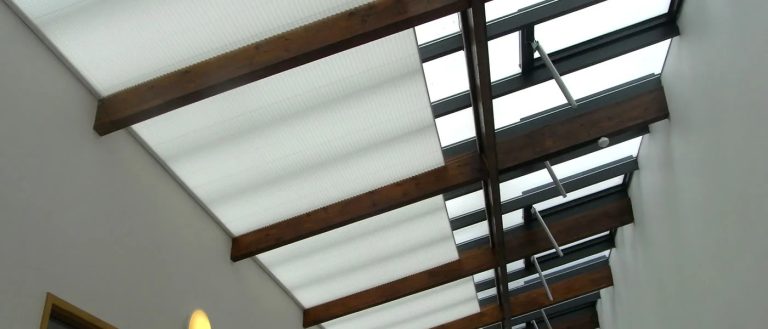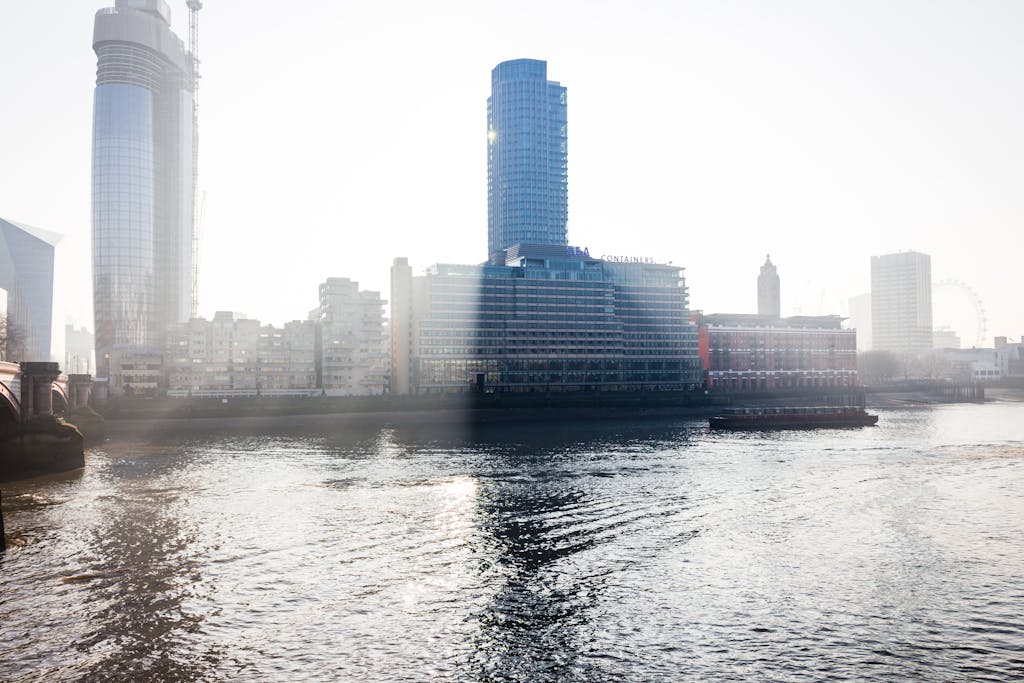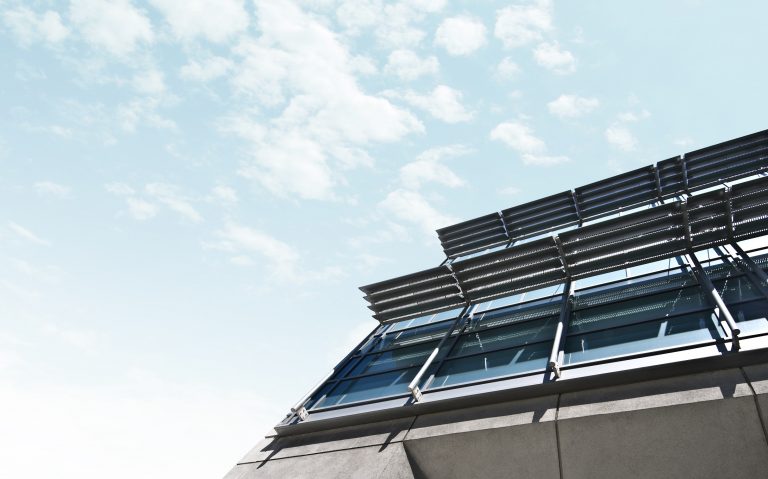Solar Shading for Energy Efficiency in Hospitals and Healthcare
Welcome to the fascinating world of energy-efficient hospital window treatments, where every shade and shutter plays a vital role in the health and healing environment.
These aren’t just window dressings; they’re key players in a hospital’s energy-saving strategy and patient comfort.
Why Window Treatments Matter
- They’re at the heart of hospital energy policies, helping facilities slash hefty energy bills and reduce waste.
- Beyond saving energy, these treatments ensure patients have a comfortable, healing environment.
- They balance the scales between saving energy and maintaining a hospital’s round-the-clock operations.
Revolutionising Hospital Spaces
Imagine a hospital room that adapts to the sun’s dance, where light and shade harmonise to offer comfort and efficiency.
They’re not just changes to the décor; they’re revolutions in window science!
Keep reading to uncover some hospital window shading ideas.
Spotlight on Alternative Treatments
These innovative window solutions are designed for the unique needs of healthcare settings:
Solar Window Films for Healthcare
- What They Do: Filter sunlight, block harmful UV rays, and keep rooms comfortably lit without the heat.
- Why They’re Great: They cut down on air conditioning and artificial lighting needs, saving energy and money.
Roller Shades
- What They Do: Provide adjustable light control at your fingertips.
- Why They’re Great: They’re simple, effective and versatile, making them a go-to for many hospitals.
Blackout Shades
- What They Do: Create complete darkness, perfect for patient rooms requiring rest and recovery.
- Why They’re Great: They ensure patients get the rest they need, anytime, day or night.
Motorised Shades
- What They Do: Adjust with the push of a button, making light control effortless.
- Why They’re Great: They bring high-tech convenience to patient comfort and energy savings.
Honeycomb Shades
- What They Do: Offer top-notch insulation, keeping rooms cosy or cool as needed.
- Why They’re Great: Ideal for common areas, they help control the climate and cut energy costs.
In the grand scheme of healthcare, where every detail contributes to healing, energy-efficient window treatments are more than just a detail.
They’re a commitment to a better, more sustainable future for all.
As we explore these options, we’re not just choosing window treatments; we’re choosing a path to a brighter, healthier world.
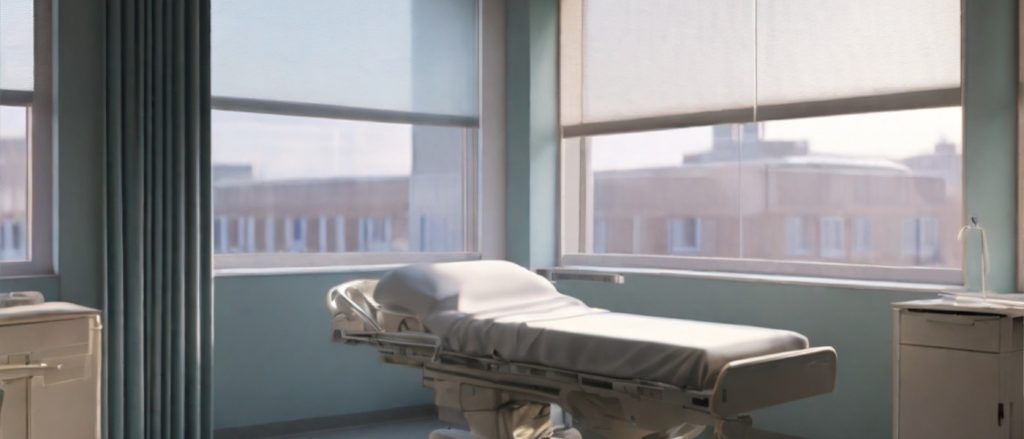
Energy Demands and Efficiency in Hospitals
Within the world of hospitals, energy is not just a utility but a lifeline.
These 24/7 healing hubs face unique energy challenges, balancing the need to power high-tech medical equipment with the necessity of creating a healing environment.
It’s a demanding dance of power and care.
The Energy Puzzle of Round-the-Clock Care
Hospitals are illuminated day and night, demanding constant energy and offering constant care.
They light up corridors, power lifesaving machinery, and keep the environment sterile and comfortable.
Every beep of a monitor and every buzz of an X-ray machine adds to a considerable energy bill.
How Windows Can Make a Difference
In this high-energy setting, something as simple as a window treatment can make a world of difference.
These are more than just blinds or shades; they’re key tools in managing energy consumption:
Smartly managing sunlight with these treatments reduces the hospital’s reliance on artificial lighting, making natural light a valuable ally.
The Challenge of Outdated Systems
In the grand scheme of hospital operations, energy-efficient window treatments play a crucial role.
This approach to energy-efficient hospital design and infrastructure is more than just a smart choice; it’s a step towards a healthier planet and a more sustainable healthcare system.
A significant part of this sustainable approach involves addressing the challenge of outdated systems, particularly in older hospital buildings.
These facilities often struggle with inefficient energy use, partly due to older windows that poorly regulate heat and light.
Retrofitting these existing windows is a strategic move to enhance energy efficiency.
The Role of Daylight and Technology
As we delve deeper into the heart of hospital efficiency, we find ourselves at the intersection of daylight and technology.
The art of daylight harvesting in healthcare facilities is more than a buzzword; it’s a transformative approach that combines the healing power of natural light with the efficiency of modern technology.
Lighting Control Strategies in Hospitals
Hospitals are turning to advanced lighting control strategies to make the best use of daylight.
This involves automated blinds, window film and sensors that adjust internal lighting based on the amount of natural light available.
It’s a dance of technology and nature, ensuring that every ray of sunlight is used to its fullest potential.
The Healing Power of Natural Light
A study in 2008 shed light on an important aspect of hospital design—patient recovery.
This research suggested a remarkable fact: exposure to natural light can positively influence recovery time following an operation by up to 8.5%.
It’s a statistic that speaks volumes about the power of the sun’s rays in the healing process.
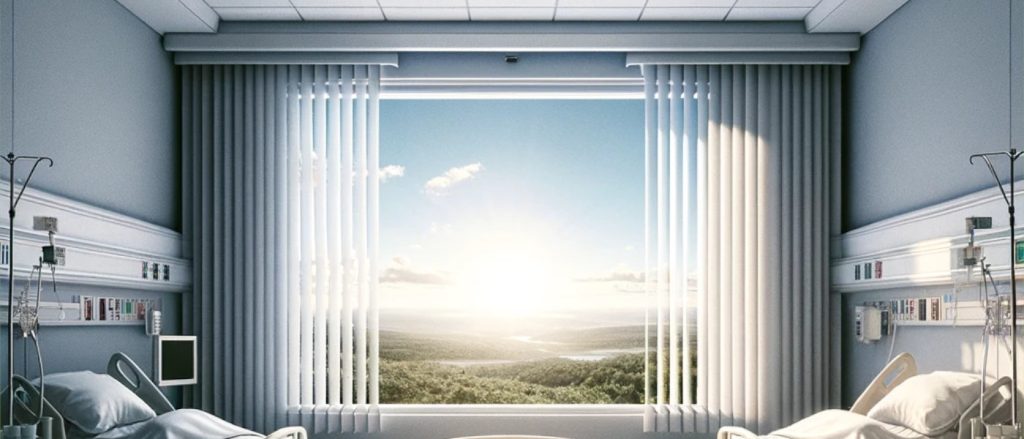
Improved Recovery Times
Natural light does more than just brighten rooms; it uplifts spirits and accelerates healing.
By incorporating more natural light into patient rooms, hospitals can significantly enhance the healing journey.
Balancing Comfort with Efficiency
Technology plays a pivotal role in balancing the use of daylight with overall energy conservation in hospitals.
By intelligently controlling how much natural light permeates a space, hospitals can ensure patient comfort while reducing their reliance on artificial heating and lighting.
Smart Solar Shading and Automated Blinds in Hospitals
Automated window treatments are not just window coverings; they’re advanced systems designed to make hospitals smarter, more energy-efficient, and more patient-friendly.
Embracing Smart Solar Shading
Smart solar shading technologies are at the cutting edge of hospital design. They intelligently regulate the amount of sunlight entering a space, thereby maintaining an optimal balance of natural light and temperature control.
- Energy Efficiency: By controlling solar gain, these systems reduce the need for artificial cooling, slashing energy costs dramatically.
- Patient Comfort: Smart shading can adjust to provide the right amount of light, ensuring patient comfort while aiding in their recovery.
The Power of Automation
Automated window blinds represent a leap forward in patient room window treatments and hospital facility management.
They’re about taking control to the next level, offering precision and ease in managing the hospital environment.
- Reduced Manual Tasks: With automation, the laborious task of manually adjusting blinds and curtains becomes a thing of the past, freeing up staff to focus on patient care.
- Enhanced Patient Care: Automation allows for the personalisation of patient environments. Patients or staff can easily adjust blinds to suit specific needs, be it by reducing glare or allowing more natural light.
The Re:fit programme emerges as a beacon for hospitals looking to retrofit their facilities for better energy efficiency.
This initiative encourages public bodies, including healthcare facilities, to adopt measures that drastically improve energy efficiency, including the implementation of smart solar shading and automated treatments.
Advantages of Motorised Window Treatments
Now, let’s compare the advantages of motorised blinds over manual blinds in healthcare facilities:
| Feature | Motorised Blinds | Manual Blinds |
| Ease of Use | Easy to operate with remote control or automation systems, accessible for patients and staff | Require physical effort and time to adjust, potentially challenging for patients or busy staff |
| Precision Control | Offer precise control over light and shade levels, can be programmed for optimal settings | Less precision, dependent on manual adjustment |
| Energy Efficiency | Can be integrated with smart systems to optimise energy use, reducing heating and cooling costs | Less efficient in energy use, as they rely on manual adjustment and lack smart integration |
| Patient Comfort | Enhance patient comfort by allowing easy adjustments from the bed or nurse station | Might not offer the same level of comfort due to the effort required for adjustments |
| Glare Reduction | Can automatically adjust to reduce glare, crucial in healthcare settings | Manual adjustments might not effectively manage glare throughout the day |
| Hygiene | Reduced physical contact, which is beneficial in a hospital environment | More contact points, which could pose hygiene challenges |
In essence, motorised window treatments are not just about convenience; they’re about transforming the hospital experience.
They bring together the best of technology and design to create environments that are both energy-efficient and conducive to healing.
As we continue to evolve in our approach to healthcare facility design, these advanced window treatments stand out as essential components in the pursuit of excellence in patient care and energy efficiency.
Benefits of Blinds and Curtains in Healthcare Settings
Far from being mere decorative elements, blinds and curtains are foundational in forging a healing atmosphere, intertwining functionality with the well-being of patients and staff.
Enhancing Hospital Environments
- Energy Efficiency: Blinds and curtains are key allies in the fight against energy waste. They provide insulation, reducing the reliance on heating and cooling systems, and manage sunlight to maintain comfortable room temperatures.
- Light Control: The ability to control light levels is crucial in a healthcare setting. These window treatments allow for the fine-tuning of natural light, aiding in patient recovery and providing a conducive work environment for staff.
- Privacy and Patient Comfort: In the sensitive setting of a hospital, privacy is paramount. Blinds and curtains offer this seclusion, enhancing the personal space of patients, which is essential for their comfort and peace of mind.
- UV Protection: Given the large window spaces in most hospitals, protecting against UV rays is a health necessity. Certain blinds and curtains can filter these rays, safeguarding patients and preserving the interior furnishings.
Solutions to Common Problems
Hospitals face unique challenges in their window treatments, from energy costs to maintenance.
Here’s how blinds and curtains offer solutions:
- Maintenance and Hygiene: Blinds and curtains designed for hospital use are often made from easy-to-clean materials, supporting the hospital’s hygiene standards.
- Customisation: Every hospital wing has different needs. Blinds and curtains can be customised for light control, privacy and aesthetics, catering to diverse requirements.
Blinds vs Curtains: A Comparative Analysis
In choosing between blinds and curtains, hospitals must weigh various factors:
| Feature | Blinds | Curtains |
| Energy Efficiency | Offer excellent insulation; can be adjusted for sunlight control | Provide good insulation; less control over sunlight |
| Light Control | Vertical or Venetian blinds have superior control with adjustable slats | Good control, depending on fabric thickness |
| Privacy | Can be adjusted for partial or full privacy | Generally offer full privacy when closed |
| UV Protection | Available with UV protective coatings | Some fabrics offer UV protection |
| Maintenance | Often easier to clean and more durable | May require more frequent cleaning; fabric dependent |
| Customisation | Highly customisable in terms of material, size and control | Wide range of fabrics and designs for aesthetic customisation |
Challenges in Implementation
Implementing the right window treatments in hospitals comes with its set of challenges:
- Balancing Energy Use and Comfort: Finding the right window treatment that conserves energy without compromising patient comfort can be challenging.
- Maintenance and Hygiene: Blinds and curtains in hospitals must be easy to clean and maintain, aligning with the stringent hygiene standards of healthcare settings.
- Customisation for Patient Needs: Hospitals must consider diverse patient needs, from light sensitivity to privacy requirements when choosing window treatments.
- Regulatory Compliance: Hospitals must navigate various regulations and standards, ensuring that their window treatments comply with energy efficiency and safety requirements.
In summary, blinds and curtains in hospitals are not just functional elements; they are vital components of the healthcare environment.
They contribute significantly to energy efficiency, patient comfort, and overall well-being, while presenting unique challenges that require thoughtful consideration and strategic implementation.
When you contract Enviroscreen for any type of shading, screening or tracking system, you can be sure that we’ll give you the attention to detail and exceptional service you require.
If you’d like to discuss a project, please fill out this form with your details and our team will be in touch with you shortly to explore how we can assist you.
Conclusion
As we draw the curtains on our exploration of window treatments in healthcare settings, it’s clear that these elements are far more than mere aesthetic enhancements.
They are pivotal components in the tapestry of patient care and environmental stewardship within healthcare facilities.
Key Takeaways:
- A Critical Role in Healthcare: Window treatments in hospitals play a significant role in patient well-being and satisfaction. They offer not just privacy and comfort but also contribute to the healing process by controlling natural light and maintaining a conducive environment.
- Energy Efficiency at its Core: The impact of these treatments on a hospital’s energy efficiency cannot be overstated. From smart solar shading to motorised blinds, each innovation marks a step towards more sustainable healthcare operations, reducing energy costs and environmental footprints.
- Technology and Comfort in Harmony: The integration of technology with window treatments has brought about a new era in healthcare facility management. Automated and motorised systems have enhanced patient comfort while ensuring that energy-saving goals are met.
- Customisation for Diverse Needs: The adaptability of window treatments to meet various requirements, from patient room privacy to UV protection in common areas, highlights their essential role in hospital design.
- Challenges as Opportunities: While the implementation of energy-efficient window treatments presents challenges, from maintenance to regulatory compliance, these are opportunities for innovation and improvement in hospital infrastructure.
As we look to the future of healthcare, the continued evolution and adoption of energy-efficient window treatment solutions will be crucial.
They represent a commitment not just to patient care but also to building a more sustainable, energy-conscious world.
References and Further Reading
For those who wish to delve deeper into the world of energy-efficient window treatments in healthcare facilities and their impact on patient care and environmental sustainability, the following resources provide a wealth of information:
- “Solar Shading Saves Energy” Infographic:
- Source: Shade It
- Description: This infographic offers a visual and concise explanation of how solar shading contributes to energy savings. It’s an excellent resource for understanding the basic principles and benefits of solar shading in healthcare facilities.
- “Drive for Energy Efficient Healthcare” Article:
- Source: NHS England
- Description: This insightful article discusses the initiatives and strategies implemented by the NHS to enhance energy efficiency in healthcare. It offers a perspective on how such measures benefit both patients and the planet, aligning with modern sustainability goals.
- Additional Suggested Readings:
- Energy-Efficient Architecture for Healthcare Facilities: Architectural digests and professional healthcare design publications often feature articles and case studies on energy-efficient designs in healthcare settings. These resources can offer valuable insights into the latest trends and technologies in hospital architecture.
- Hospital Facility Management: Facilities management publications and online resources can provide practical advice and case studies on the effective management of window treatments in hospital settings. They offer a real-world perspective on challenges, solutions, and best practices.
Frequently Asked Questions (FAQs)
What is Energy Conservation in Healthcare?
Energy conservation in healthcare means reducing energy use in medical facilities while ensuring patient care remains high. This involves using efficient technologies and methods, like energy-saving lighting and window treatments.
How Do Window Treatments Contribute to Energy Efficiency in Hospitals?
Window treatments help control light and temperature in hospitals. By managing sunlight and heat, they reduce the need for artificial lighting and climate control, thus saving energy.
What Are the Benefits of Motorised Window Treatments in Healthcare Settings?
Motorised window blinds offer ease of use, improved patient comfort, and better energy efficiency. They can be easily adjusted and programmed for optimal light and temperature control.
What Should Be Considered When Choosing Window Treatments for Hospitals?
When selecting window treatments for hospitals, consider energy efficiency, maintenance ease, patient comfort and compliance with safety regulations. They should offer effective light control and be easy to clean.
For enquiries about solar shading:
Enviroscreen Systems
Swift House,
13 Ronsons Way,
St Albans,
AL4 9QT
United Kingdom
Telephone: 01727 220 007
E-mail: info@enviroscreen.org.uk

